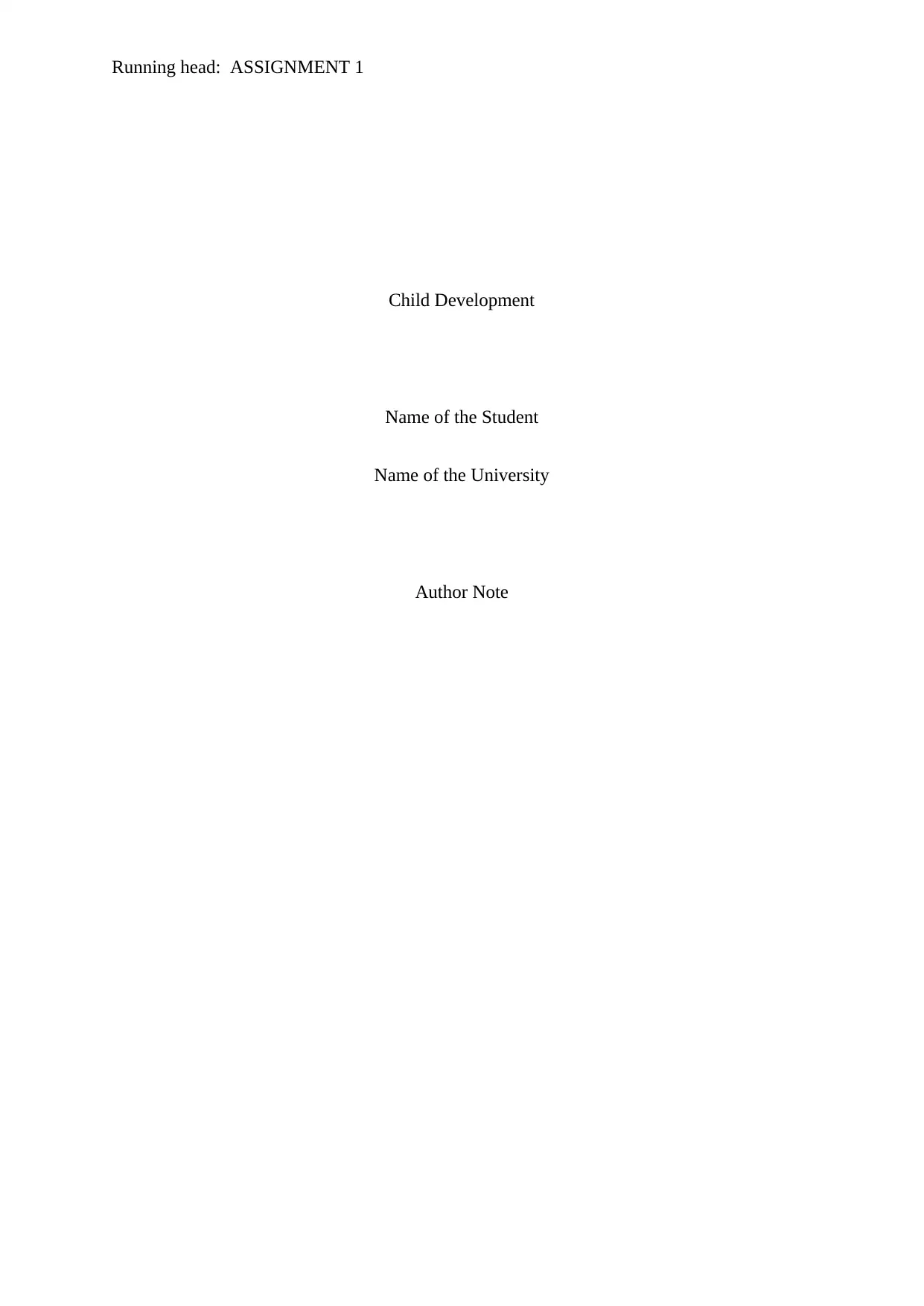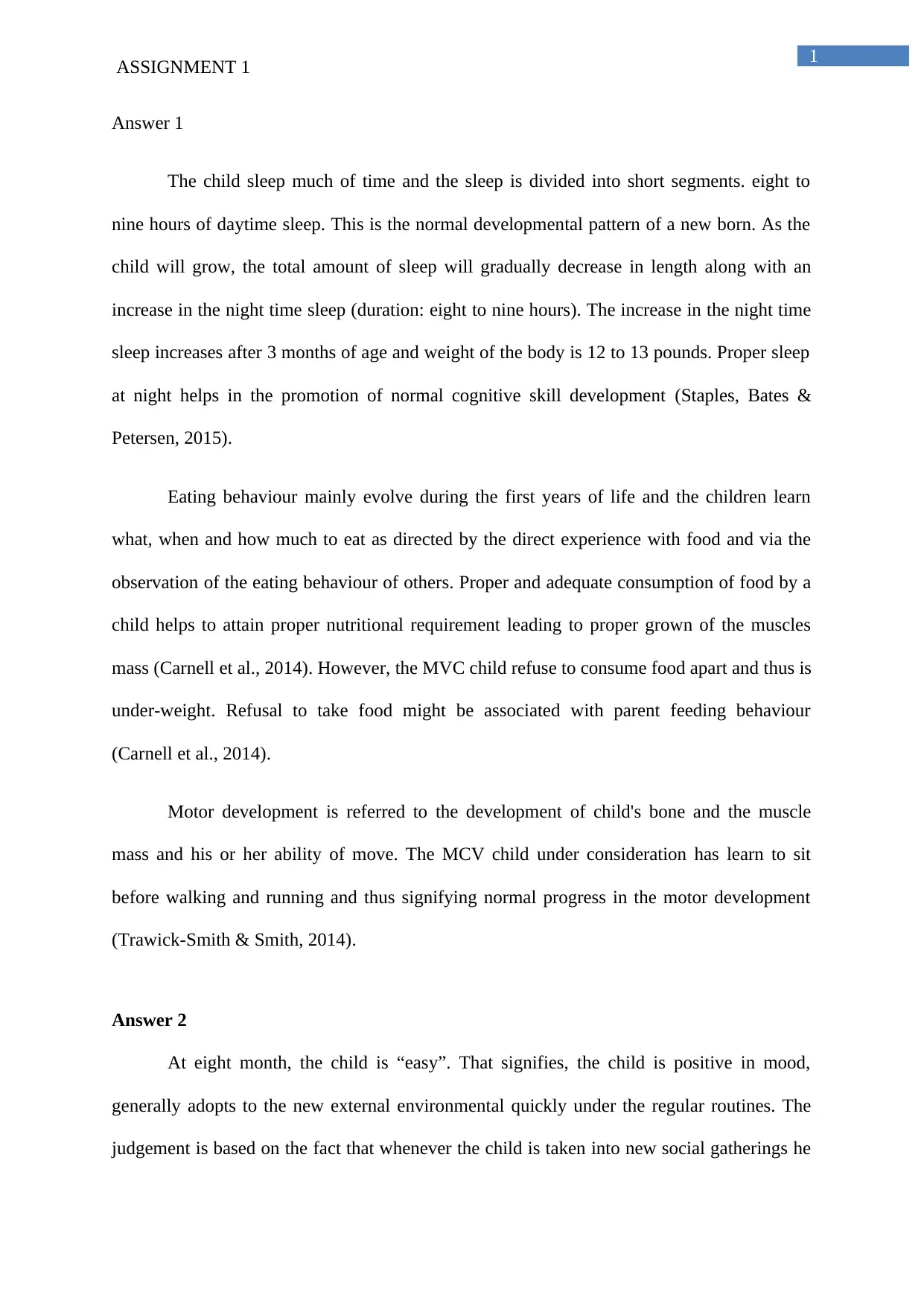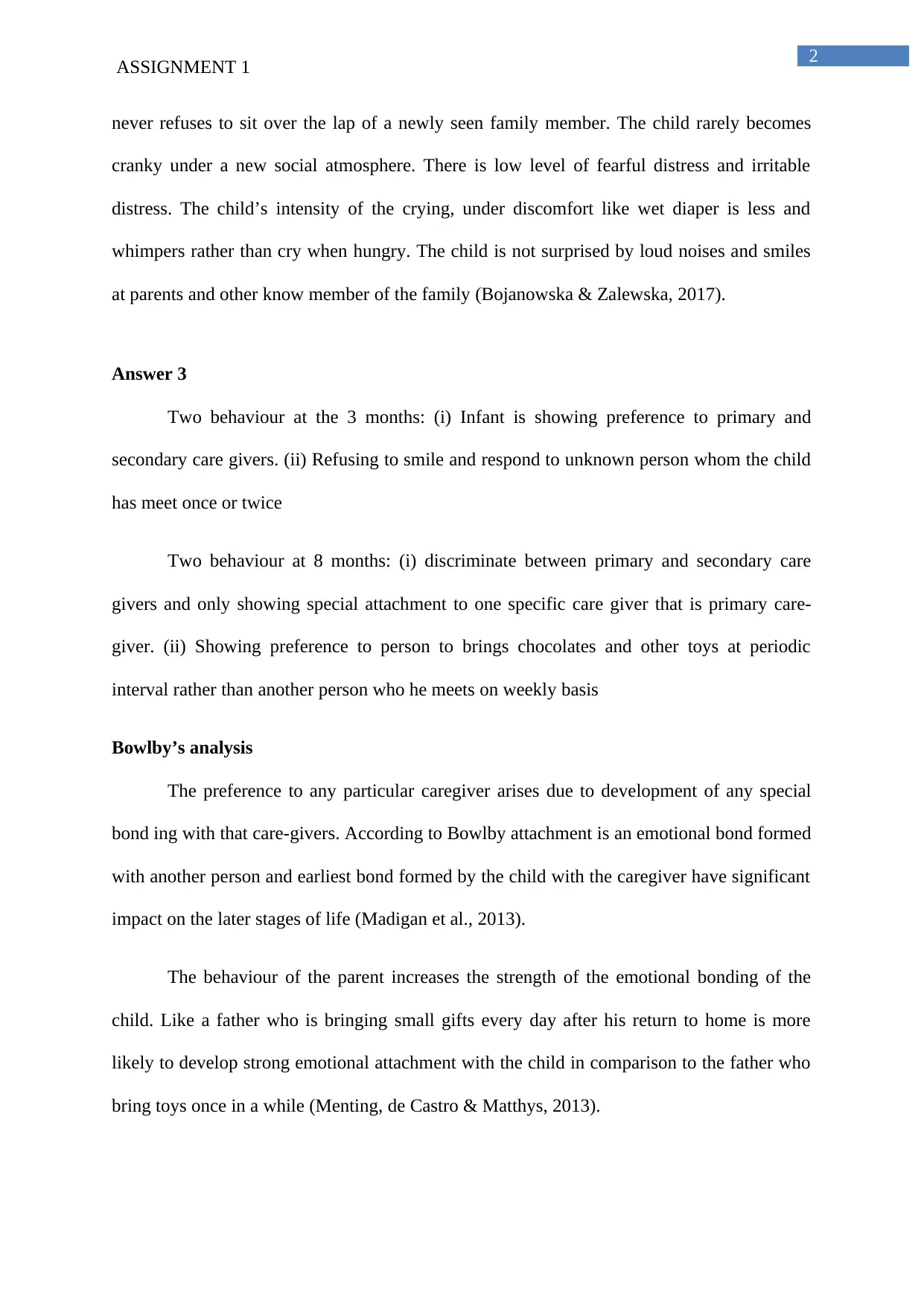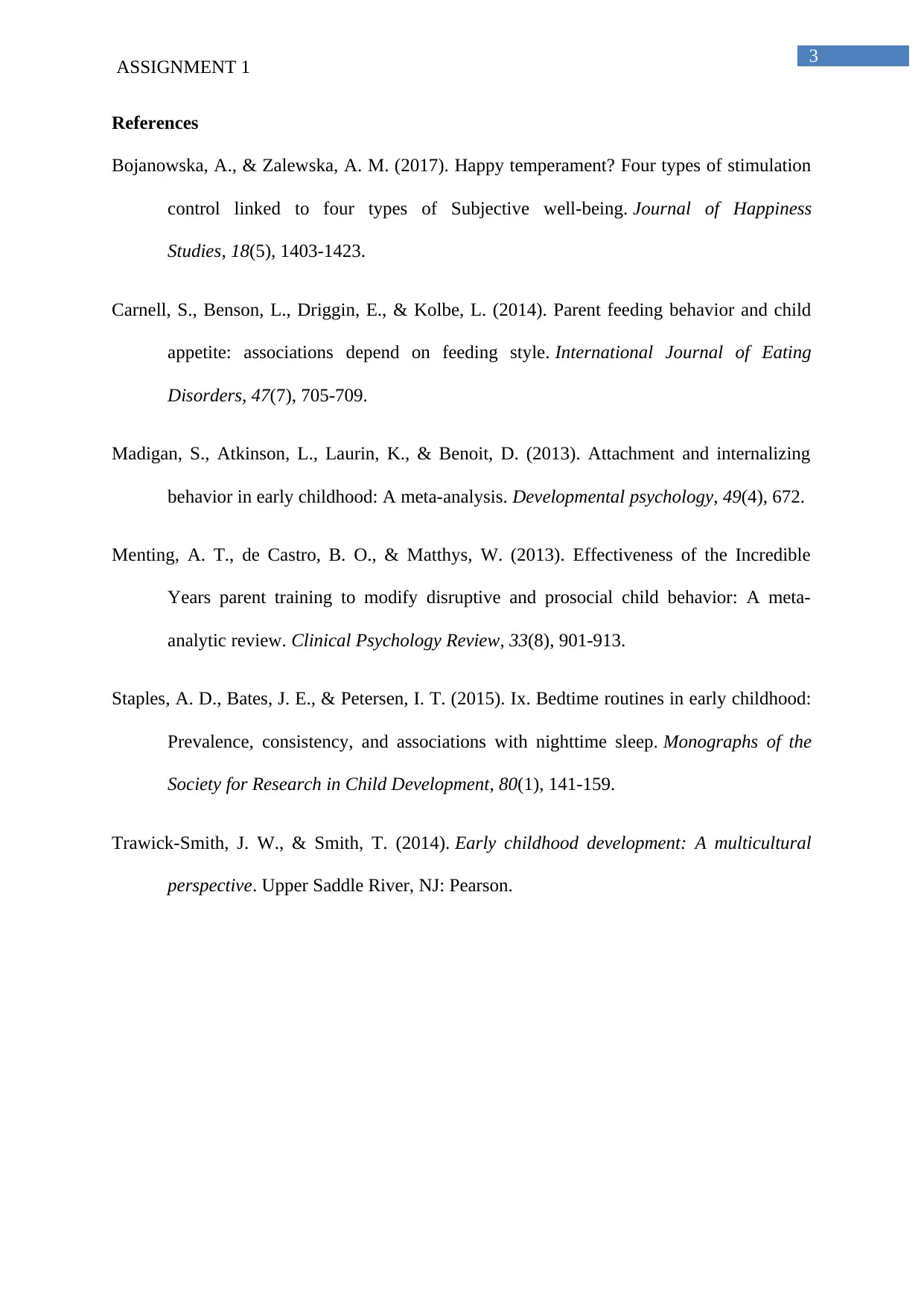Child Development Assignment: Comparing Child Development Patterns
VerifiedAdded on 2023/04/05
|4
|758
|102
Homework Assignment
AI Summary
This assignment analyzes a child's development in comparison to typical developmental patterns, focusing on eating, sleeping, and motor skills. The student compares their child's behavior to expected norms, considering Thomas and Chess's temperamental categories and Bowlby's attachment theory. The assignment assesses the child's temperament as "easy" and provides supporting observations. It also explores changes in the child's preferences and attachments over time, relating them to Bowlby's insights on caregiver bonds. The student uses textbook information and examples from their child to address the assignment questions, demonstrating an understanding of child development concepts. References are provided to support the analysis.

Running head: ASSIGNMENT 1
Child Development
Name of the Student
Name of the University
Author Note
Child Development
Name of the Student
Name of the University
Author Note
Paraphrase This Document
Need a fresh take? Get an instant paraphrase of this document with our AI Paraphraser

1
ASSIGNMENT 1
Answer 1
The child sleep much of time and the sleep is divided into short segments. eight to
nine hours of daytime sleep. This is the normal developmental pattern of a new born. As the
child will grow, the total amount of sleep will gradually decrease in length along with an
increase in the night time sleep (duration: eight to nine hours). The increase in the night time
sleep increases after 3 months of age and weight of the body is 12 to 13 pounds. Proper sleep
at night helps in the promotion of normal cognitive skill development (Staples, Bates &
Petersen, 2015).
Eating behaviour mainly evolve during the first years of life and the children learn
what, when and how much to eat as directed by the direct experience with food and via the
observation of the eating behaviour of others. Proper and adequate consumption of food by a
child helps to attain proper nutritional requirement leading to proper grown of the muscles
mass (Carnell et al., 2014). However, the MVC child refuse to consume food apart and thus is
under-weight. Refusal to take food might be associated with parent feeding behaviour
(Carnell et al., 2014).
Motor development is referred to the development of child's bone and the muscle
mass and his or her ability of move. The MCV child under consideration has learn to sit
before walking and running and thus signifying normal progress in the motor development
(Trawick-Smith & Smith, 2014).
Answer 2
At eight month, the child is “easy”. That signifies, the child is positive in mood,
generally adopts to the new external environmental quickly under the regular routines. The
judgement is based on the fact that whenever the child is taken into new social gatherings he
ASSIGNMENT 1
Answer 1
The child sleep much of time and the sleep is divided into short segments. eight to
nine hours of daytime sleep. This is the normal developmental pattern of a new born. As the
child will grow, the total amount of sleep will gradually decrease in length along with an
increase in the night time sleep (duration: eight to nine hours). The increase in the night time
sleep increases after 3 months of age and weight of the body is 12 to 13 pounds. Proper sleep
at night helps in the promotion of normal cognitive skill development (Staples, Bates &
Petersen, 2015).
Eating behaviour mainly evolve during the first years of life and the children learn
what, when and how much to eat as directed by the direct experience with food and via the
observation of the eating behaviour of others. Proper and adequate consumption of food by a
child helps to attain proper nutritional requirement leading to proper grown of the muscles
mass (Carnell et al., 2014). However, the MVC child refuse to consume food apart and thus is
under-weight. Refusal to take food might be associated with parent feeding behaviour
(Carnell et al., 2014).
Motor development is referred to the development of child's bone and the muscle
mass and his or her ability of move. The MCV child under consideration has learn to sit
before walking and running and thus signifying normal progress in the motor development
(Trawick-Smith & Smith, 2014).
Answer 2
At eight month, the child is “easy”. That signifies, the child is positive in mood,
generally adopts to the new external environmental quickly under the regular routines. The
judgement is based on the fact that whenever the child is taken into new social gatherings he

2
ASSIGNMENT 1
never refuses to sit over the lap of a newly seen family member. The child rarely becomes
cranky under a new social atmosphere. There is low level of fearful distress and irritable
distress. The child’s intensity of the crying, under discomfort like wet diaper is less and
whimpers rather than cry when hungry. The child is not surprised by loud noises and smiles
at parents and other know member of the family (Bojanowska & Zalewska, 2017).
Answer 3
Two behaviour at the 3 months: (i) Infant is showing preference to primary and
secondary care givers. (ii) Refusing to smile and respond to unknown person whom the child
has meet once or twice
Two behaviour at 8 months: (i) discriminate between primary and secondary care
givers and only showing special attachment to one specific care giver that is primary care-
giver. (ii) Showing preference to person to brings chocolates and other toys at periodic
interval rather than another person who he meets on weekly basis
Bowlby’s analysis
The preference to any particular caregiver arises due to development of any special
bond ing with that care-givers. According to Bowlby attachment is an emotional bond formed
with another person and earliest bond formed by the child with the caregiver have significant
impact on the later stages of life (Madigan et al., 2013).
The behaviour of the parent increases the strength of the emotional bonding of the
child. Like a father who is bringing small gifts every day after his return to home is more
likely to develop strong emotional attachment with the child in comparison to the father who
bring toys once in a while (Menting, de Castro & Matthys, 2013).
ASSIGNMENT 1
never refuses to sit over the lap of a newly seen family member. The child rarely becomes
cranky under a new social atmosphere. There is low level of fearful distress and irritable
distress. The child’s intensity of the crying, under discomfort like wet diaper is less and
whimpers rather than cry when hungry. The child is not surprised by loud noises and smiles
at parents and other know member of the family (Bojanowska & Zalewska, 2017).
Answer 3
Two behaviour at the 3 months: (i) Infant is showing preference to primary and
secondary care givers. (ii) Refusing to smile and respond to unknown person whom the child
has meet once or twice
Two behaviour at 8 months: (i) discriminate between primary and secondary care
givers and only showing special attachment to one specific care giver that is primary care-
giver. (ii) Showing preference to person to brings chocolates and other toys at periodic
interval rather than another person who he meets on weekly basis
Bowlby’s analysis
The preference to any particular caregiver arises due to development of any special
bond ing with that care-givers. According to Bowlby attachment is an emotional bond formed
with another person and earliest bond formed by the child with the caregiver have significant
impact on the later stages of life (Madigan et al., 2013).
The behaviour of the parent increases the strength of the emotional bonding of the
child. Like a father who is bringing small gifts every day after his return to home is more
likely to develop strong emotional attachment with the child in comparison to the father who
bring toys once in a while (Menting, de Castro & Matthys, 2013).
⊘ This is a preview!⊘
Do you want full access?
Subscribe today to unlock all pages.

Trusted by 1+ million students worldwide

3
ASSIGNMENT 1
References
Bojanowska, A., & Zalewska, A. M. (2017). Happy temperament? Four types of stimulation
control linked to four types of Subjective well-being. Journal of Happiness
Studies, 18(5), 1403-1423.
Carnell, S., Benson, L., Driggin, E., & Kolbe, L. (2014). Parent feeding behavior and child
appetite: associations depend on feeding style. International Journal of Eating
Disorders, 47(7), 705-709.
Madigan, S., Atkinson, L., Laurin, K., & Benoit, D. (2013). Attachment and internalizing
behavior in early childhood: A meta-analysis. Developmental psychology, 49(4), 672.
Menting, A. T., de Castro, B. O., & Matthys, W. (2013). Effectiveness of the Incredible
Years parent training to modify disruptive and prosocial child behavior: A meta-
analytic review. Clinical Psychology Review, 33(8), 901-913.
Staples, A. D., Bates, J. E., & Petersen, I. T. (2015). Ix. Bedtime routines in early childhood:
Prevalence, consistency, and associations with nighttime sleep. Monographs of the
Society for Research in Child Development, 80(1), 141-159.
Trawick-Smith, J. W., & Smith, T. (2014). Early childhood development: A multicultural
perspective. Upper Saddle River, NJ: Pearson.
ASSIGNMENT 1
References
Bojanowska, A., & Zalewska, A. M. (2017). Happy temperament? Four types of stimulation
control linked to four types of Subjective well-being. Journal of Happiness
Studies, 18(5), 1403-1423.
Carnell, S., Benson, L., Driggin, E., & Kolbe, L. (2014). Parent feeding behavior and child
appetite: associations depend on feeding style. International Journal of Eating
Disorders, 47(7), 705-709.
Madigan, S., Atkinson, L., Laurin, K., & Benoit, D. (2013). Attachment and internalizing
behavior in early childhood: A meta-analysis. Developmental psychology, 49(4), 672.
Menting, A. T., de Castro, B. O., & Matthys, W. (2013). Effectiveness of the Incredible
Years parent training to modify disruptive and prosocial child behavior: A meta-
analytic review. Clinical Psychology Review, 33(8), 901-913.
Staples, A. D., Bates, J. E., & Petersen, I. T. (2015). Ix. Bedtime routines in early childhood:
Prevalence, consistency, and associations with nighttime sleep. Monographs of the
Society for Research in Child Development, 80(1), 141-159.
Trawick-Smith, J. W., & Smith, T. (2014). Early childhood development: A multicultural
perspective. Upper Saddle River, NJ: Pearson.
1 out of 4
Your All-in-One AI-Powered Toolkit for Academic Success.
+13062052269
info@desklib.com
Available 24*7 on WhatsApp / Email
![[object Object]](/_next/static/media/star-bottom.7253800d.svg)
Unlock your academic potential
Copyright © 2020–2025 A2Z Services. All Rights Reserved. Developed and managed by ZUCOL.